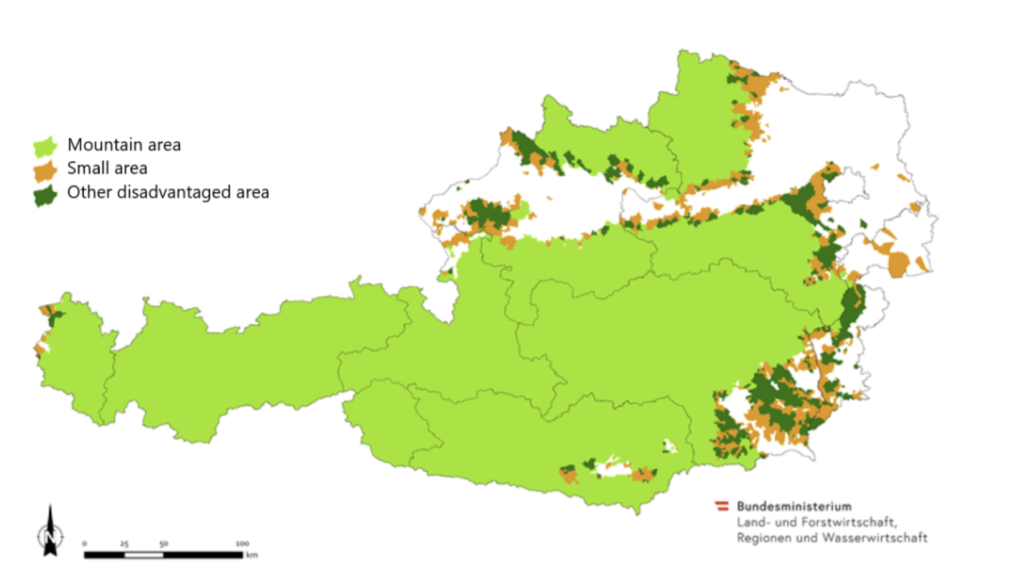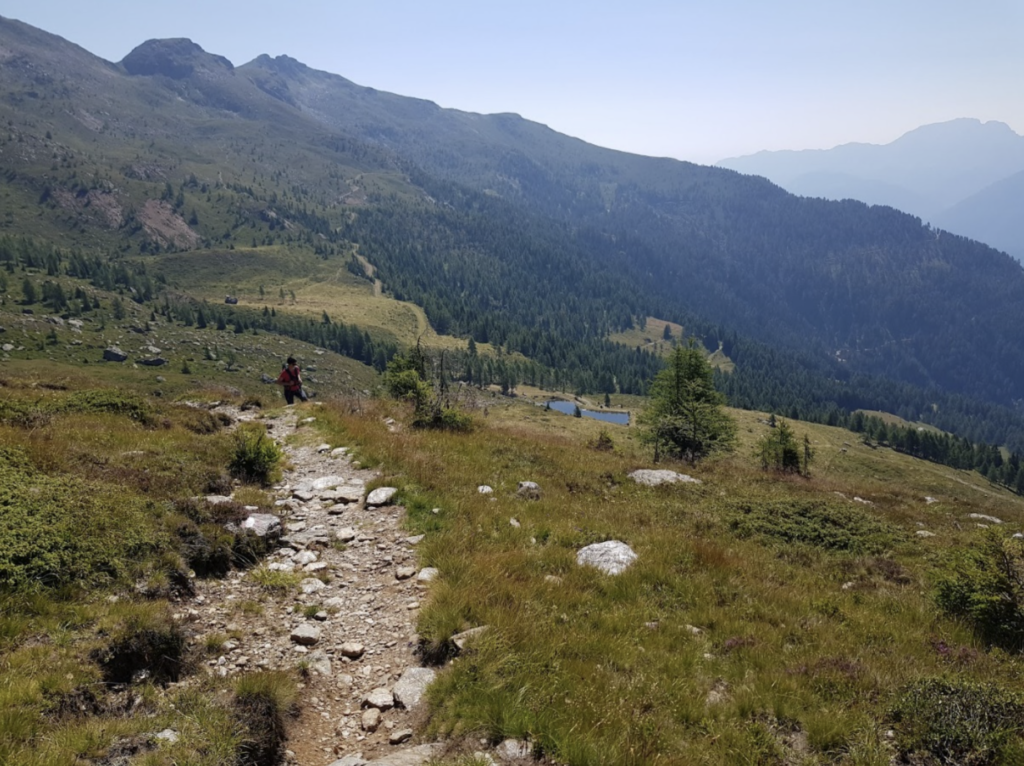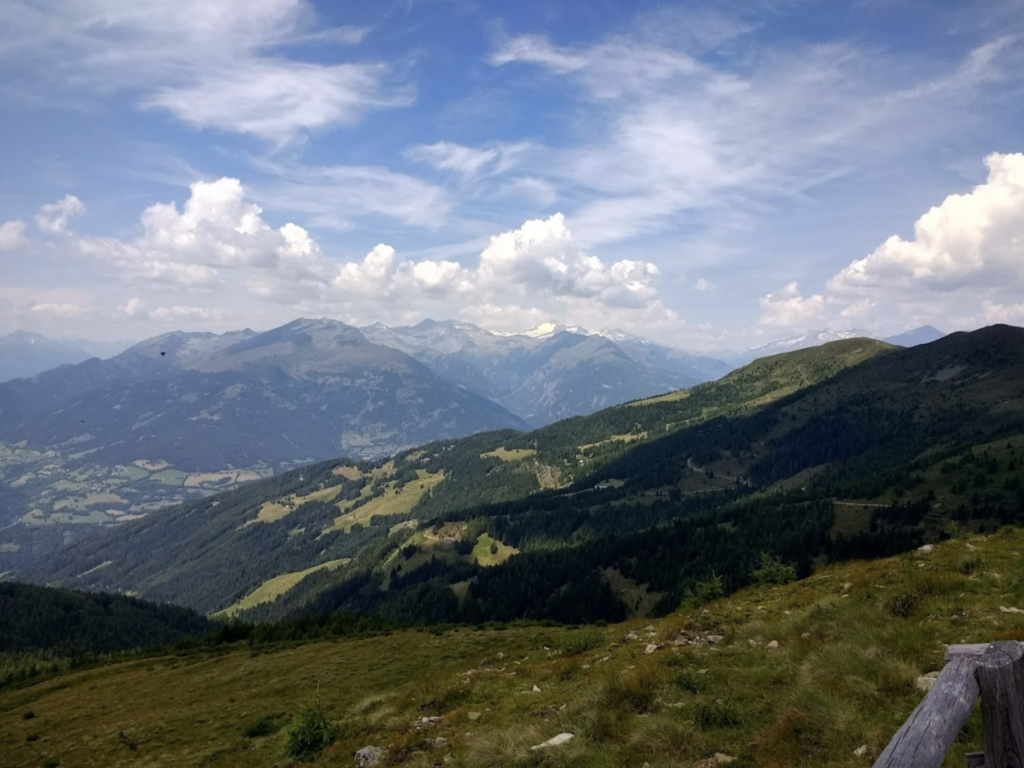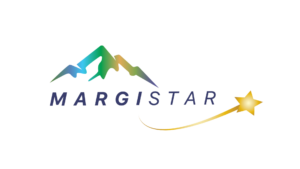By Ingrid Machold, Thomas Dax, and Somaye Latifi (Federal Institute of Agricultural Economics, Rural and Mountain Research (BAB), Vienna)
Mountain areas form a significant part of Austria, covering 70% of its territory and hosting 56% of all its farms. Austrian mountains, however, are also often classified as disadvantaged regions due to topographical and climatic factors. Farming in these high-elevation areas presents challenges, but also yields quality products vital for sustaining local cultures. In the face of economic challenges, policy support and off-farm activities have significantly improved living conditions for mountain farm households. Read on to better understand how policy-making can positively impact mountain farming and its role in sustaining cultural landscapes and providing employment in Austria’s mountainous regions.
Mountain areas are an important feature of Austria, covering 70% of the Austrian territory and comprising 56% of all farms in the country (BML, 2023). Because of this, many regions in Austria are either classified as mountain areas or other disadvantaged areas (Figure 1). For the maintenance of cultural landscapes in these disadvantaged regions, especially in mountainous areas, farm land use is of particular importance (Gruber et al., 2018).

For centuries, farming has formed the basis of many livelihoods in Austrian mountain communities (Wilson et al., 2018). Farming at high elevations is mostly carried out in small- scale farming systems which tend to achieve smaller production quantities, but often generate high-quality products. This has led to significant challenges and income gaps for mountain farms. However, because of tight linkages to off-farm activities and a strong policy commitment towards mountain farming overall, living conditions for Austrian mountain farm households have improved. Areas affected by marginalisation processes in Austria are today limited to rather small parts of the country’s mountain areas, particularly in the Eastern part of the Alps (Dax and Wiesinger, 2008).
Why is mountain farming important in preventing the marginalisation of mountain areas?
Mountain farming generally offers a variety of products and services and is thus an inherent feature of many Austrian mountainous areas. Small-scale farms are usually considered tools for providing public goods and maintaining multifunctional landscapes (Ricciardi et al., 2021; Dax and Hovorka, 2004). In the Alps, animal husbandry and sustained grassland management systems are significant in preserving variated landscape structures. These include high pastures, steep mountain meadows, dry grassland biotopes, and damp meadows in some valleys. Similarly, mountain farms are of great importance for forest protection and the management of Alpine pasture areas, which are extremely sensitive ecosystems (Dax and Wiesinger, 2008).
Farming in the European Alps is based on family farming and provides not only livelihoods for individual families, but also shapes the cultural landscape for recreational and touristic uses (Flury et al., 2013). Alpine farming systems also play a vital role in sustaining biodiversity, as traditional land management creates heterogeneity and niches that serve as habitats for many different species ( Wrbka et al., 2004 ).
When managed sustainably, mountain farming in Austria represents a harmonious relationship between people and mountain nature and is a multidimensional practice that combines agricultural, environmental, cultural, and economic benefits. It plays a crucial role in maintaining the balance between human activities and natural ecosystems in mountain areas and serves as a key source of employment and income for marginalised mountain communities in Austria.
What are the specific challenges of mountain farming in Austria?
Austria’s mountain farming faces various specific challenges due to the unique nature of farming practices in unfavourable natural conditions. The economic viability of mountain farming is often challenged by the limited size and productivity of arable land, high production costs due to difficult natural conditions, remoteness from markets, low accessibility, and disadvantages in competing with lowland producers. The lower productivity of traditional farming practices in mountain areas – aggravated by climate change, ageing farming populations, and lacking interest amongst younger generations – has further made these farming systems at risk of disappearing (Drexler et al., 2016).
Remote mountain communities in the Austrian Alps have undergone substantial socio-economic changes over the past decades, including a decrease in farm numbers and farmland area and an overdependence on tourism as a main form of income (Zucca, 2009). Using agricultural land as infrastructure or for recreational facilities can reduce available farmland. In many mountain areas, additional concerns like agricultural abandonment and an aging farming population are brought about by the outmigration of young people (Dax et al., 2021). The abandonment of farm management not only affects the agricultural sector, but might also negatively affect the regional economies and the viability of socio-economic structures (Dax and Wiesinger, 2008).

Is mountain farming in Austria resilient?
With rising ecological concerns and threats of land abandonment, the resilience of mountain farming against threats and crises has become decisive. Traditional adapted land management systems are endangered as the realities of life and work in mountain agriculture have changed significantly in recent decades and will continue to be influenced by large-scale influences in the future. Nevertheless, it seems that farmers in mountain areas of Austria have been able to adapt comparably well to changing external influences and assert themselves economically. This is reflected in the proportion of farms active in mountain areas in comparison to the total number of farms in Austria, which has risen from 50% in 2000 to almost 56% in 2022 (embedded in circumstances that led to a simultaneous loss of one third of all funded farms during this period) (BML, 2023, p.79). This comparably favourable outcome is considered at least partially a result of longstanding and comprehensive mountain policy support.
Mountain farming in Austria shows a substantial degree of resilience. Nevertheless, resilience can vary strongly depending on location, farming practices, regional contexts, and the ability to adapt to changing conditions. Mountain farming in Austria benefits from supportive policies, experiences with sustainable practices, and cultural preservation efforts that contribute to its resilience. Continued efforts to address specific regional challenges and adapt to changing conditions are essential in maintaining and strengthening the resilience of mountain farming in Austria.


The role of policy in resilient mountain farming in Austria
Mountain farming plays a key role in preserving sensitive mountain ecosystems through the maintenance of multifunctional landscapes and the high quality of living and working spaces in these areas (OECD, 1998). In Austria, the multifunctionality of mountain farming in regard to environmental impacts, local food production, threat of land abandonment, natural hazards, and rural development has been perceived as a subject of national concern (Hovorka and Dax, 2009). Mountain farming in Austria is supported by a range of policies and initiatives aimed at providing targeted support to farmers in marginalised areas and promoting sustainable agriculture, economic viability, and the preservation of cultural heritage.
By pursuing these objectives, Austria provided a substantial financial support programme for mountain farmers as early as the 1970s and 1980s, namely the “Special Support Program for Mountain Areas” (Dax, 2020), to secure the diverse functions of mountain farming. Over decades, a differentiated support system has been put in place to provide direct payments and subsidies to mountain farmers in acknowledgement of the beneficial functions of their agricultural activities. These payments are often linked to the maintenance of traditional farming practices and the protection of natural resources. Payments focus on handicap- oriented support and targeted agri-environmental schemes that encourage farmers to adopt environmentally friendly practices. These schemes may include incentives for organic farming, landscape conservation, and biodiversity protection. The structure and amount of these support payments have an important impact on farmers’ incomes, ensuring continued agricultural land use, and maintaining multifunctional farming in the mountain areas of this country (Hovorka and Dax, 2009).
The long-term implementation and reliability of these policies collectively contribute to the resilience and sustainability of mountain farming in Austria, ensuring that these unique and challenging environments continue to thrive. The Austrian experience shows that successful policies built to safeguard environmental and cultural landscapes in mountain areas require the incorporation of spatially oriented sectoral policies in integrated regional development strategies (Dax, 2001; Weber-Hajszan and Gmeiner, 2023).


The header image shows Semmering in Austria and was taken by Gerhard Hovorka.
References
Bundesministerium für Land- und Forstwirtschaft, Regionen und Wasserwirtschaft (BML) (2023). Grüner Bericht 2023. Die Situation der österreichischen Land- und Forstwirtschaft gemäß § 9 des
Landwirtschaftsgesetzes. Wien. https://gruenerbericht.at/cm4/jdownload/send/2-gr-bericht-terreich/2586-gb2023
Dax, T. (2020). Regional perspective of mountain policy. Lessons from implementation in Austria. In: Goussios, D., Gaki, D., Garnier A., Lerin, F. (Eds.). Mountain areas of large Mediterranean island. European issues, National and Regional policies and local mechanism. European Conference of Troodos-Cyprus, 28-31 January 2020. University of Thessaly Press, Volos, Greece.
file:///C:/Users/somaye.latifi/Downloads/Troodos-EN-_web.pdf
Dax, T. (2001). Endogenous Development in Austria’s Mountain Regions, from a Source of Irritation to a Mainstream Movement. Mountain Research and Development 21 (3): 231-235.
https://www.jstor.org/stable/3674074
Dax, T. and Hovorka, G. (2004). Integrated rural development in mountain areas. In: F. Brouwer (Ed.). Sustaining Agriculture and the Rural Environment: Governance, Policy and Multifunctionality, pp. 124-43. Cheltenham, UK and Northampton, MA, USA: Edward Elgar Publishing. https://www.e-elgar.com/shop/gbp/sustaining-agriculture-and-the-rural-environment-9781843762560.html
Dax, T. and Wiesinger, G. (2008). Rural amenities in mountain areas. In: F. Brouwer, T. Van Rheenen, S.Dhilion and A. Elgersma (Eds.). Sustainable Land Management, pp. 131-148. Cheltenham, UK and Northampton, MA, USA: Edward Elgar Publishing. https://www.elgaronline.com/edcollchap/book/9781782543480/book-part-9781782543480-15.xml
Dax, T., Schroll, K., Machold, I., Derszniak-Noirjean, M., Schuh, B. and Gaupp-Berghausen, M. (2021). Land Abandonment in Mountain Areas of the EU: An Inevitable Side Effect of Farming Modernization and Neglected Threat to Sustainable Land Use. Land 10(6) 591: 1-17. doi:10.3390/land10060591 https://www.mdpi.com/2073-445X/10/6/591
Drexler, C., Braun, V., Christie, D., Claramunt, B., Dax, T., Jelen, I., Kanka, R., Katsoulakos, N., Le Roux, G., Price, M., Scheurer, T. and Weingartner, R. (2016). Mountains for Europe‘s Future – A strategic research agenda. MRI, Berne & IDG, Innsbruck.
https://www.mountainresearchinitiative.org/images/MRI_Publications/Mountains_for_Europes_Future_2016.pdf
Flury, C., Huber, R. and Tasser, E. (2013). Future of mountain agriculture in the Alps. In: S. Mann (Ed.). The Future of Mountain Agriculture, pp. 105-126. Berlin: Springer. https://link.springer.com/chapter/10.1007/978-3-642-33584-6_8
Gruber, M., Kanonier, A., Pohn-Weidinger, S. and Schindelegger, A. (2018). Spatial planning in Austria with references to spatial development and regional policy, publication series No. 202. Vienna: office of the Austrian Conference on Spatial Planning (ÖROK). https://www.oerok.gv.at/fileadmin/user_upload/publikationen/Schriftenreihe/202/OEROK-
SR_202_EN.pdf
Hovorka, G. and Dax, T. (2009). Mountain Farming Support in Austria. Mountain Forum Bulletin IX (1): 26-27. https://lib.icimod.org/record/14056
OECD (1998). Rural Amenity in Austria, A Case Study of Cultural Landscape. Paris: OECD Group of the Council on Rural Development, C/RUR (98)4. https://one.oecd.org/document/C/RUR(98)4/en/pdf
Ricciardi, V., Mehrabi, Z., Wittman, H., James, D. and Ramankutty, N. (2021). Higher Yields and More Biodiversity on Smaller Farms. Nature Sustainability 4 (7): 651-657. doi: 10.1038/s41893-021-00699-2 https://www.nature.com/articles/s41893-021-00699-2
Zucca, M. (2009). The Alps. The people: anthropology of small communities. Demographic
movements. Women’s condition. Development perspectives. Mountain research and development
29 (1): 106. doi: 10.1659/mrd.mm044.
https://bioone.org/journals/mountain-research-and-development/volume-29/issue-
1/mrd.mm044/The-Alps-The-People–Anthropology-of-Small-Communities-
Demographic/10.1659/mrd.mm044.full
Weber-Hajszan, L. and Gmeiner, P. (2023). Benachteiligte Gebiete und Berggebiete in der
landwirtschaftlichen Strukturförderung, Grundlagenarbeit der BAB für die Ausgleichszulage in
benachteiligten Gebieten. In: T. Oedl-Wieser and I. Machold (Eds.). Zur Zukunft der Berggebiete.
Reflexionen zu Regional- und Berggebietsentwicklung, pp. 19-23. BAB Report 006. Wien:
Bundesanstalt für Agrarwirtschaft und Bergbauernfragen, pp. 19-23. https://bab.gv.at/index.php?option=com_content&view=article&id=2272:bab-report-006-zur-
zukunft-der-berggebiete&catid=139&lang=de&Itemid=567
Wilson, G., Schermer, M. and Stotten, R. (2018). The resilience and vulnerability of remote mountain communities: the case of Vent, Austrian Alps. Land Use Policy 71: 372-383. doi:
10.1016/j.landusepol.2017.12.022 https://www.sciencedirect.com/science/article/abs/pii/S0264837717308141?via%3Dihub
Wrbka, T., Peterseil, J., Schmitzberger, I. and Stocker-Kiss, A. (2004). Alpine Framing in Austria, for nature, culture or economic need? The new dimensions of the European Landscapes 4: 165-177. https://library.wur.nl/ojs/index.php/frontis/article/view/1010


